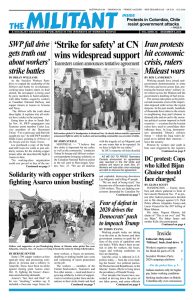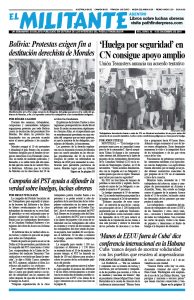Working people have joined anti-government demonstrations in some 100 cities and towns across Iran, protesting the Iranian rulers’ military intervention across the Mideast and the government’s doubling of fuel prices.
The actions take place as the political and economic crisis of the imperialist-imposed order across the region deepens. In the past month, hundreds of thousands have taken to the streets in neighboring Iraq and Lebanon to demand jobs and an end to the sectarian political system imposed in both countries — a system that the Iranian rulers have used to consolidate their influence there. In Iraq, demonstrators demanded Tehran’s military forces — which the Iraqi rulers depend on to defend their interests — leave the country.
Protests by workers and youth in Iran were triggered by the regime’s removal of fuel subsidies Nov. 15. Beginning in the southwest, in Ahwaz, an Arabic-speaking province that borders Iraq, the actions rapidly swept the country to Tabriz, Mashhad, Isfahan, Khorramshahr, Shiraz and the capital, Tehran.
Demonstrators in Mashhad, Behbahan, Ahwaz and Chabahar chanted, “Oil revenue has gone missing, it’s been spent in Palestine,” reported Rudaw.
For years, the Iranian government has funded and helped organize Islamic Jihad and Hamas in Gaza; Hezbollah, an armed group in Lebanon; and militias across Syria and Iraq, where it has established military bases and transports rockets to Hezbollah to target Israel. The bloody toll of the Iranian rulers’ wars are borne by working people, including in Iran.
In the Kurdish region of Urmia in Iran, demonstrators chanted, “The enemy is here,” referring to the hated clerical government. In Tehran, students shouted, “Death to the regime.”
The government’s riot police were backed by a mobilization of half a million of the murderous Basij paramilitary force, which is linked to the Islamic Revolutionary Guard Corps. Between 100 and 200 demonstrators have been killed by live fire, including from snipers. Over 1,000 have been arrested. The regime claimed it has suppressed the demonstrations. Similarly, Iran’s militias in Iraq are used by the Iraqi government to kill anti-government demonstrators there.
Less than two years ago demonstrations swept Iran, fueled by the exposure of huge government spending on religious institutions linked to the capitalist rulers’ Revolutionary Guard, which has been central to recruiting the militias they use to extend their regional clout.
Since then, the Iranian rulers’ crisis has sharpened as economic conditions worsen for working people while Tehran has continued to bolster its regional military incursions. Inflation has soared to 50% while wages stagnate in a contracting economy, deepened with the reimposition of crippling sanctions by Washington that constrict oil exports.
“Nothing propels mounting resistance more than the privileged classes’ military adventures and wars,” writes Socialist Workers Party leader Steve Clark, in the party’s statement “Revolution, Counterrevolution and War in Iran.”
Through pressing working people into their military service, Clark says, “The Iranian bourgeoisie’s aim is to increase its regional power and influence by force of arms, extending beyond Iran’s borders the nearly four-decade-long political, cleric-dominated counterrevolution that pushed back the workers, farmers, women and oppressed nationalities who carried out the historic Iranian Revolution of 1979.” The statement is available on the Militant’s website.
IDF missiles hit Iran’s forces in Syria
The Israeli rulers have stepped up their assaults aimed at pushing back the buildup of Tehran’s proxy forces in Syria. In the biggest attack by the Israeli Defense Forces in Syria in 18 months, its warplanes attacked more than 20 military sites near the capital, Damascus, Nov. 20. The assault was in retaliation for four rockets fired towards the Golan Heights the previous day by Iranian-commanded forces in Syria. All four of Tehran’s rockets were downed by Israeli anti-missile defenses.
Facilities of the Iranian Quds Force, some inside Syrian bases, as well as six Syrian surface-to-air missile batteries were hit, killing 23 people. Two were civilians; five were Syrian soldiers; and the other 16, Iranian or Tehran-backed fighters.
The government in Iran has repeatedly vowed to destroy the state of Israel. It has used its intervention in Syria to help turn the Syrian civil war in favor of its ally, the Bashar al-Assad tyranny, and to strengthen its forces there.
IDF spokesperson Brig. Gen. Hidai Zilberman said, “We will not let Iran entrench in Syria,” repeating the often-stated aim of the Israeli rulers.
Tel Aviv gave notice of its airstrikes to the command of Moscow’s forces in Syria. The Israeli strikes avoided Russian-supplied S-300 missile batteries stationed there. Mikhail Bogdanov, Russian deputy foreign minister, criticized the attacks, saying they violated Syrian sovereignty. But Moscow took no action to defend Assad’s forces from Tel Aviv’s bombardment.

